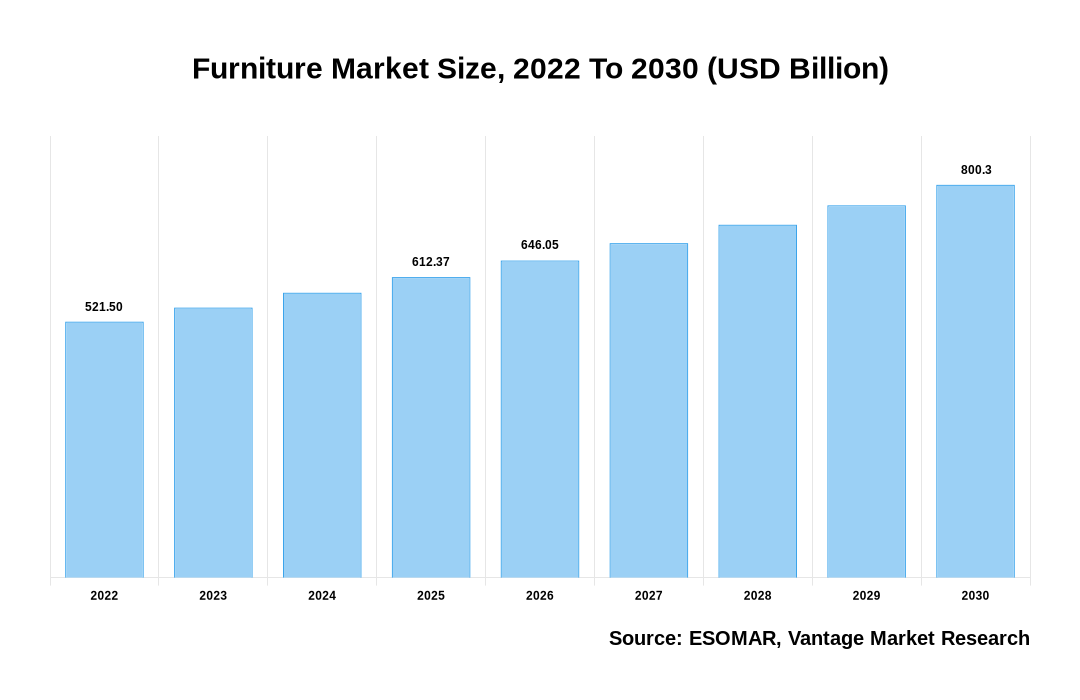Global Furniture Market
As stated in our extensive report; the Global Furniture Market accounted for USD 521.5 Billion in 2022 and is projected to reach a value of USD 800.3 Billion by 2030.
The Furniture market refers to the industry and marketplace, which includes the buying and selling of Furniture items. It has various types of Furniture, such as chairs, tables, sofas, beds, cabinets, etc., made from different materials like wood, metal, plastic, or fabric. The Furniture market is a significant sector within the broader retail industry. It caters to residential and commercial consumers, providing Furniture for homes, offices, hotels, restaurants, schools, hospitals, and other institutions.
The Furniture market is influenced by various factors such as consumer preferences, design trends, material availability, manufacturing technologies, and economic conditions. It is a highly competitive industry where companies constantly strive to innovate and meet customer demands for quality, style, and affordability. The market is also impacted by sustainability and eco-friendly practices, with a growing demand for environmentally conscious Furniture options. Additionally, online Furniture retail has gained significant traction in recent years, allowing customers to shop conveniently from home and enhancing market competitiveness.
Click To Get a Free Sample On the Research Study

These are the primary factors that must be considered to propel the growth of the global Furniture market. However, One major restraint is the high cost of raw materials. As the prices of wood and other materials used in Furniture production increase, it becomes challenging for manufacturers to maintain competitive prices.
Key factors influencing Furniture Market Growth
The growth of the global Furniture market can be attributable to the following:
- The overall state of the economy can significantly impact the Furniture market. During economic growth, consumers have more disposable income for Furniture, leading to increased demand. Conversely, during economic downturns, consumers may cut back on discretionary purchases like Furniture, leading to decreased demand.
- Demographic factors such as population rise, age distribution, and household size can influence the demand for Furniture. For example, as the population grows and more households are formed, there is a greater need for Furniture. Additionally, trends such as urbanization and an aging population can influence the types of Furniture in demand.
- Consumer preferences for different styles and designs of Furniture can significantly impact the market. For example, there has been a shift towards more minimalist and multifunctional Furniture in recent years. Lifestyle changes, such as a growing focus on home office spaces and outdoor living areas, can also drive demand for specific types of Furniture.
- Technological advancements can impact the Furniture market in various ways. For instance, the rise of e-commerce and online shopping has made Furniture more accessible to consumers, leading to increased sales. Moreover, technological advancements in materials and manufacturing processes can also influence the types of Furniture available and the prices at which they are offered.
- Consumer awareness and environmental concerns have increased the demand for sustainable and eco-friendly Furniture. This demand has prompted Furniture manufacturers to develop more environmentally friendly products, such as using recycled materials or sustainable sourcing practices. The implementation of regulations and certifications related to sustainability can also impact the Furniture market.
- The level of competition within the Furniture market and the actions of key players can influence overall market growth. Factors such as pricing strategies, product innovation, marketing efforts, and distribution channels can all impact the growth and market share of companies within the industry.
- Government policies and laws can significantly influence the Furniture market. For example, changes in import/export regulations, tax policies, and labor laws can impact the production cost and distribution, affecting the pricing and availability of Furniture in the market.
Asia Pacific Region to Lead the Market
Asia Pacific Furniture market is getting more significant with maximum market share during the forecast period. With rapid urbanization, increasing disposable income, and a growing middle-class population, the demand for Furniture in this region has been consistently rising. Emerging countries such as China, India, Japan, South Korea, and Australia have emerged as the key contributors to the growth of the Furniture market in this region. Additionally, the presence of numerous manufacturers, both local and international, has further boosted the Furniture market in Asia Pacific. These manufacturers offer Furniture products catering to various customer preferences and budgets. The popularity of online shopping platforms has also contributed to the market’s growth, as consumers can easily search and purchase Furniture from the comfort of their homes.
Conclusion
The growing real estate sector and the rise of e-commerce platforms is positively influencing the overall Furniture market.
Some of the key players in the Global Furniture Market include- Harman Miller Inc. (U.S.), Steelcase Inc. (U.S.), HNI Corporation (U.S.), Ashley Furniture, Industries Inc. (U.S.), Duff & Phelps LLC. (U.S.), Global Furniture USA (U.S.), ZouYou (China), P & C ArteMobili SA (Brazil), Saudi Modern Factory Co. (Saudi Arabi and others.
![[Market Research Reports] – Research Google News Blog | VMR.Biz](https://www.vmr.biz/wp-content/uploads/2022/12/logo-removebg-preview.png)











